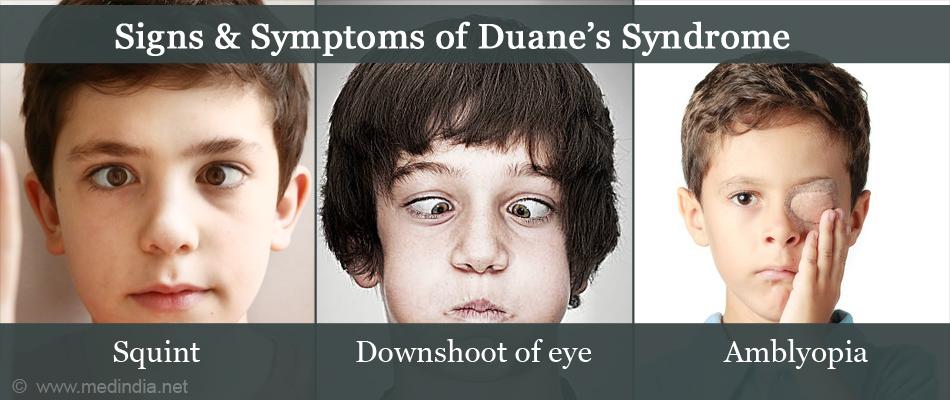- Duane Syndrome - (https://www.ncbi.nlm.nih.gov/pubmed/20301369)
- Causes of Duane syndrome - (https://en.wikipedia.org/wiki/duane_syndrome#causes)
- Eye Conditions - Duane’s Syndrome - (http://www.whitefield.org.uk/attachments/download.asp?file=105&type=pdf)
- What can we learn from the thalidomide experience: an ophthalmologic perspective - (https://www.ncbi.nlm.nih.gov/pmc/articles/pmc3713624/)
What is Duane’s Syndrome?
Duane’s syndrome is a congenital non-progressive form of squint or strabismus. The sideways movement of the eyeball is impaired and the eyelids open and close inappropriately as the eyes turn. The outward movement of the eye away from the nose (abduction) and similarly the inward movement of the eye looking toward the nose (adduction) is defective.
The condition was first recognized by ophthalmologists Jakob Stilling (1887) and Sigmund Turk (1896) but was described in detail by Alexander Duane in 1905 after whom it is named.
Other names used to refer to this disorder include Duane's retraction syndrome (DRS), eye retraction syndrome, congenital retraction syndrome retraction syndrome, and Stilling-Türk-Duane syndrome.
Epidemiology of Duane’s Syndrome
Duane’s syndrome may affect one or both eyes, with the left eye involved more often for reasons not known. Duane’s syndrome is seen more frequently in females. Most cases are diagnosed by 10 years of age. There is no particular race predilection.
About 10-20% cases are familial and these are more likely to be bilateral than the sporadic form of Duane’s syndrome (80%).
It is a rare condition affecting 1 in 10000 persons and accounts for between 1-5% of all squint cases.
Muscles that Produce Eye Movements and Their Nerve Supply - In Brief
To understand what goes wrong in Duane’s syndrome, it is important to know how the eye muscles function to move the eye in various directions. There are normally, six muscles on the outside of each eyeball which allow us to move the eye in all directions as needed. These eye muscles are innervated by nerves which control the eye movement.
Normally the muscle that moves the eyeball laterally outward away from the nose is the lateral rectus muscle innervated by the abducent (cranial nerve VI) nerve. The eye muscle that moves the eyeball inward to look at the nose is the medial rectus and it is innervated by the oculomotor (cranial nerve III) nerve.
For normal eye movement to occur, both the muscle and its nerve supply must be intact. The brain sends electrical signals along nerve fibres to the muscles causing eye movement. These nerve fibres and muscles are formed much before we are born.
What are the Causes of Duane’s Syndrome?
- Duane syndrome is caused by a “miswiring” of the nerves that supply eye muscles. The abducent nerve that supplies the lateral rectus muscle does not develop, and thus this muscle cannot function properly. However, instead, the muscle gets a twig from the oculomotor nerve which also supplies the medial rectus muscle which has the opposite movement of the lateral rectus muscle.

Therefore when the eye attempts to look sideways, the opposing medial rectus muscle also will be stimulated, thus limiting abduction or outward movement and instead the eye appears to retract into the socket with the eyelids opening and closing inappropriately.
- In some cases, which involve both eyes (bilateral DRS), mutation in the CHN1 gene have been noted leading to familial DRS.
- Exposure to thalidomide of the fetus in early pregnancy (20-26 days) has been shown to be associated with an increased risk of Duane’s syndrome.
What are the Types of Duane’s Syndrome?
Duane’s is subdivided into three types, which are distinct entities with unique features.
Type 1: Impaired ability of involved eye/eyes to move outward towards the ear, but the ability to move towards the nose is near normal
Type 2: Impaired ability to move inward towards the nose, but the ability to move outward away from the nose is near normal
Type 3: Limited ability of affected eye/eyes to move both inward toward the nose as well as outward away from the nose
What are the Signs and Symptoms of Duane’s Syndrome?
- Squint: the eyes may be misaligned and point in different directions some or all of the time
- Abnormal head position: children often maintain an abnormal head posture or turn their head to keep the eyes aligned or straight
- Upshoot or downshoot of eye: when attempting outward movements, the eye may deviate upward or downward
- Amblyopia (reduced vision in the affected eye): occurs in a small proportion of cases
- Eyelid narrowing: the affected eye may appear smaller than the other eye

How do you Diagnose Duane’s Syndrome?
Examination of eye movements and visual acuity by the eye specialist will raise the suspicion of the diagnosis. Other tests that may be performed to confirm the diagnosis and determine the residual function of the involved eye muscle. These include
Magnetic resonance imaging (MRI) of the brainstem – may reveal small or absent abducent nerve nucleus and nerve; the optic, oculomotor and trochlear nerves may also be poorly developed
Electromyography of eye muscle - may demonstrate degree of activity in the lateral rectus muscles ranging from no activity during outward eye movement to essentially equal activity in both outward and inward eye movements.
How do you Treat Duane’s Syndrome?
Goal of treatment is to reduce squint, prevent or reduce abnormal head posturing and prevent vision impairment in the affected eye
Conservative Management
- Children diagnosed with Duane’s syndrome most often do not require any treatment. They have to be followed up by the eye doctor regularly to check for vision.

- Most children will have normal vision, although in some cases, glasses may be prescribed to achieve best vision.
- In some children, it may be necessary to use an eye patch over the normal eye to prevent Duane’s eye from becoming lazy leading to visual impairments.
- Fresnel prisms attached to glasses may be prescribed to avoid abnormal head posturing.
Surgery
Surgical correction may be necessary if the eyes are misaligned even when looking straight, there is significant head turning to see properly, or there is marked upshooting or downshooting of the eyes.
Surgery will improve vision although it will not make the eye movements normal. This is because the main problem is in the signaling from the brain which cannot be modified by surgery.
How do you Prevent Duane’s Syndrome?
- Sporadic Duane’s syndrome cannot be prevented as they occur spontaneously in offspring of normal parents.
- However persons with familial DRS wherein other family members are also similarly affected, may be advised to seek genetic counselling to understand the risk of having an affected baby. Prenatal diagnosis is possible for pregnancies at increased risk i.e. if the condition is present in a family member.
Health Tips
- Children with Duane’s may turn their heads to improve vision, and this should be urged
- If glasses are advised, they should be worn constantly and kept in good clean condition
- Visual images and written matter should be presented centrally
- Acquiring typing skills will be useful since handwriting may be affected
- Hand eye coordination may be impaired as is the ability to perform fine motor tasks; these may be improved by providing greater visual contrast during such activities
- Difficulties in vision and focusing may make these children reluctant to participate in group activities; parents and teachers should encourage their active participation








